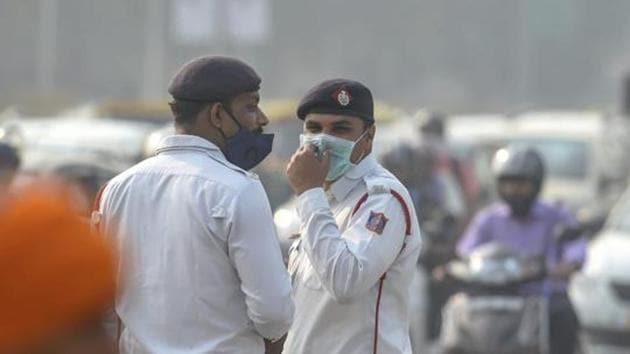Delhi enveloped in smog as wind blows in smoke from farm fires in Punjab, Haryana
Delhi’s air quality deteriorated sharply on Monday to fall in the severe category for the second time within a week. The overall air quality index on Monday was registered in the severe category at 418, a drastic decline from a day before when the AQI was moderate at 171.
The air quality deteriorated sharply as a change in wind pattern swept in smoke from farm fires in Punjab and Haryana on Monday, shrouding the national capital region (NCR) in a thick haze made of tiny particulate matter that can penetrate deep into the lungs and cause health problems.

Levels of PM2.5 shot up nearly five times in 24 hours – a phenomenon that officials said was not recorded in the three years since hourly monitoring began for the region. Sunday was the best November day since 2015.
Scientists from government agencies said they expected pollution to increase but were taken aback by how fast it happened. “The prediction was that air quality could deteriorate to ‘very poor’ levels. We have not encountered such an overnight spike in the last three years at least,” said an official of the Central Pollution Control Board (CPCB).
The average Air Quality Index (AQI) value shot up from 171 on Sunday to 426 on Monday, settling in the ‘severe’ category, which is the second worst of five classifications of pollution.
According to the System of Air Quality and Weather Forecasting And Research (Safar), at least 33% of the pollutants originated from fires in farms in Punjab and Haryana, where farmers set fire to crop residue ahead of the next round of sowing later this month.
Satellite images from the United States’s National Aeronautical Space Agency (Nasa) showed that between Friday and Sunday, at least 5,000 instances of crop burning were seen in Punjab.
A farmer leader said fields are still to be cleared and there will likely be more instances between Tuesday and Saturday, a period that is also likely to be affected by pollution from Diwali celebrations.
Bharatiya Kisan Union (BKU) general secretary in Punjab, Harinder Singh Lakhowal, said the problem was that many farmers could not afford to use machinery that could clear crop residue. “Those who can afford the additional diesel costs during the use of machinery are not burning stubble. Rest of the farmers are helpless,” he said.
But till now, he added, only about 30% of crop residue has been cleared through burning.
Adding to the problem are the atmospheric conditions – high moisture content, calm winds near the surface and strong currents in the upper atmosphere that are bringing the farm fire pollutants it. “It is almost as if there is a rain of particulate matter, which is being brought in by the upper air currents and being trapped in the moist, still surface air,” a Delhi environment department official said, asking not to be named since he was not authorised to speak to the media.
According to forecasts, the air pollution might relent to ‘very poor’ category – when AQI is between 300 and 400 – on Tuesday before it starts climbing back up again from Wednesday.
Experts said that at this point, it was crucial that officials in NCR made sure that restrictions in place to curb local emissions were being followed. “Commuters must use public transport to minimise the use of private vehicles, which is a major contributor to local emission,” said Anumita Roy Chowdhury, executive director (research and advocacy), Centre for Science and Environment.
Doctors, meanwhile, reiterated that people should avoid outdoor exposure, particularly strenuous activity.
Particularly at risk are children, said Dr Krishan Chugh, paediatric pulmonologist, Fortis Memorial Research Institute (FMRI), Gurugram. “A child gets affected by all components of polluted air, and each of these components are known to cause serious harm. So, imagine what will happen to a child’s lungs when all these pollutants are collectively inhaled in heavy measure,” he said.
Hospitals and clinics have already recorded an increase in number of people coming in with pulmonary problems.
(With inputs from HTC in Patiala)






